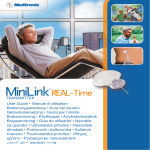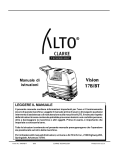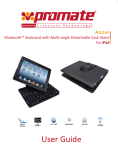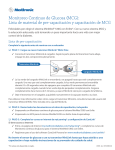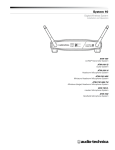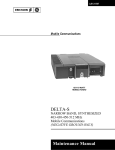Download User Guide - Medtronic Diabetes UK
Transcript
User Guide MiniLink tester MiniLink (transmitter) MiniLink charger A complete MiniLink kit includes: • • • MiniLink (MMT-7703) MiniLink charger (MMT-7705) MiniLink tester (MMT-7706) • • • AAA alkaline battery(ies) Occlusive dressing Sen-serter® Indications for use The MiniLink is indicated for use as a component of select Medtronic continuous glucose sensing systems and Medtronic MiniMed sensorenabled pump systems. Contraindications None known. Warnings Product contains small parts and may pose a choking hazard for young children. Do not use the MiniLink to send glucose readings to the monitor while onboard an aircraft. Disconnect the MiniLink from the sensor while travelling on an aircraft or if interference with other transmitting devices occurs. -1- English The Medtronic MiniLink™ transmitter (MiniLink) is a component of select continuous glucose sensing systems and sensor-enabled insulin pump systems. The MiniLink powers the glucose sensor, collects glucose data, and wirelessly sends the data to a monitor. The monitor is a Medtronic continuous glucose sensing monitor or Medtronic MiniMed sensorenabled insulin pump. The sensor should be removed if redness, bleeding, pain, tenderness, irritation, or inflammation develops at insertion site, or if you experience unexplained fever. An optional occlusive dressing should be removed if irritation or reaction to the tape develops. The sensor may create special needs regarding your medical conditions or medications. Discuss with your doctor before using the sensor. Wait 5 minutes after sensor insertion before connecting the transmitter to the sensor. • Make sure that the site is not bleeding before connection. • If bleeding occurs, apply steady pressure with a sterile gauze or clean cloth at the insertion site until bleeding stops. After bleeding stops, attach the MiniLink to the sensor. • If bleeding persists after 3 minutes, remove the sensor and discard. Insert a new sensor in a different location. Contact the HelpLine or your local representative listed on the enclosed International Contact card if you experience any adverse reactions associated with the MiniLink or sensor. Note: The MiniLink is designed to withstand common electromagnetic interference, including airport security systems. Precautions Establish a rotation schedule for choosing new sensor sites. Avoid sites that are constrained by clothing, have scar tissue, or are subject to rigorous movement during exercise. FCC notice This device complies with the United States Federal Communications Commission (FCC) and international standards for electromagnetic compatibility. This device complies with Part 15 Rules. Operation is subject to the following two conditions: (1) this device may not cause harmful interference, and (2) this device must accept any interference received, including interference that may cause undesirable operation. The MiniLink does not interfere with any radio frequency signals transmitted from outside sources.These FCC standards are designed to provide reasonable protection against excessive radio frequency interference and prevent undesirable operation of the device from unwanted electromagnetic interference. -2- RF Interference from other devices Common consumer electronic devices that transmit in the same frequency band used by the MMT-7703 MiniLink transmitter may prevent the receiving device (Guardian REAL-Time monitor or Paradigm REALTime insulin pump) from receiving the glucose information sent by the transmitter. Most cellular phones and 900 MHz cordless phone, when transmitting or receiving, may cause significant interruption of transmitterreceiver communication. It is likely that other devices operating in similar frequency ranges will have a similar effect. This interference, however, will not cause any incorrect data to be sent and will not cause any harm to your MiniLink. Guardian REAL-Time monitors and Paradigm REAL-Time insulin pumps include a programmable “Weak Sensor” alert that notifies you when one or more expected MiniLink transmissions were not received as expected by the receiving device. (The receiving device will also issue a “Lost Sensor” alert if communication is interrupted for approximately 40 minutes.) Communication problems can typically be resolved by ensuring that the distance between transmitter and receiving device is less than 6 feet, and by turning off or moving away from other RF transmitting devices. You can also reorient or relocate the MiniLink and/or the receiving device to try to correct the interference. Testing conducted with several different cellular phones suggests that interference will not be a problem if the phone is at least 12 inches from the transmitter or receiving device while it is being used (greater separation distance may be required for certain devices). -3- English Important: Changes or modifications not expressly approved by the party responsible for compliance could void the user’s authority to operate the equipment. MiniLink charger The MiniLink contains a non-replaceable, rechargeable battery that you can recharge as needed with the charger. The charger has a green light that shows the charging status and a red light that communicates any problems during charging. If you see a red light, see the Troubleshooting section. The charger needs a AAA battery to operate. Installing a new charger battery 1 Remove charger battery cap by turning it counter-clockwise 1/4 turn using a coin in the groove of the cap. 2 Insert a new AAA battery with the flat (-) end first. Make sure that you align the small bumps on the battery cap with the small notches in the charger’s battery opening. Push in the cap all the way using a coin. Turn the cap clockwise 1/4 turn to close. 3 If the battery is installed incorrectly or is low, the charger will not work. Repeat the steps above using a new battery. Note: A new AAA battery contains enough power to recharge the MiniLink more than 40 times. Charging the MiniLink Before using the MiniLink for the first time, you must fully charge the MiniLink battery which may take up to 8 hours. It is recommended to recharge the MiniLink after each sensor use. A fully charged MiniLink battery will work more than 14 days without recharging. Note: When connecting the MiniLink to the charger, always allow at least one minute before disconnecting or the MiniLink will NOT work properly. If you disconnect your MiniLink before one minute, reconnect it to the charger for at least one minute. 1 Insert the MiniLink into the charger by lining up the MiniLink connector (flat side down) with the charger. Push the two components together fully. Note: If a green light on the MiniLink is lit or flashing, do not connect the MiniLink to the charger. The MiniLink will not charge with its green light on. Wait for the -4- 3 4 Setting up the MiniLink The serial number is on the flat side of the transmitter, as shown on the right. See your monitor user guide for steps on entering this number. SN GT2XXXXXXM MEDTRONIC MINIMED MiniLink Transmitter REF MMT-7703XX SN GT2XXXXXXM Connecting to the sensor The MiniLink must be fully charged before connecting it to the sensor. 1 After the sensor is inserted (follow the instructions provided with your sensor), wait 5 minutes before connecting the transmitter. Check for bleeding. Make sure that bleeding has stopped (see Warnings page for details), then connect the MiniLink to the sensor. 2 Touch the inserted sensor at back of assembly to prevent movement. 3 Hold the MiniLink as shown to line up the two notches on both sides with the flexible side arms of the sensor. The MiniLink flat side with the label sensor should face the skin. 4 Slide the MiniLink onto the sensor FCC D: OH27703 IC: 3458-7703 1234 -5- IPX8 English 2 green light to turn off (about 30 seconds) and then connect it to the charger. Within 10 seconds after the MiniLink is green light connected, a green light on the charger will flash for 1-2 seconds as the charger powers on. For the rest of the charging time, the charger’s green light will flash on and off every second. When charging is complete, the green light on the charger will stay on, without flashing, for 15-20 seconds and then turn off. After the green charger light turns off, disconnect the MiniLink from the charger. The green light on the MiniLink will flash for about 5 seconds and then turn off. Your MiniLink is now ready to use. See the picture on the right. 5 6 7 and push it in firmly until the flexible side arms of the sensor “click” into the notches on both sides of the MiniLink. In the next 20 seconds the MiniLink will flash green for about 10 seconds with a proper connection. If the MiniLink light does not flash, disconnect it from the sensor, wait for several seconds and then reconnect. If the MiniLink light still does not flash, charge the MiniLink. After the MiniLink light flashes green, use your monitor to start communicating with the sensor and to start the sensor initialization (see your monitor user guide for instructions). After the MiniLink successfully sends signals to the monitor, you may choose to put an occlusive dressing over the MiniLink and the sensor. Bathing and swimming After the MiniLink and sensor are connected, they form a water-tight seal to a depth of 8 feet (2.4 meters) for up to 30 minutes. You can shower and swim without removing them. No occlusive dressing is needed. Disconnecting from sensor 1 Hold the MiniLink as shown, and pinch the flexible side arms of the sensor between your thumb and forefinger. 2 Gently pull the MiniLink away from the sensor assembly. MiniLink tester The blue tester is used to test the MiniLink and to make sure it is working. Connecting the tester 1 Hold the MiniLink and the tester as shown. Line up the flat side of the tester with the flat side of the MiniLink. 2 Push the tester into the MiniLink until the flexible side arms of the tester click into the notches on both sides of the MiniLink. 3 Within 20 seconds the green light on the MiniLink will flash for about 10 seconds when properly connected. 4 Check the sensor icon on the monitor to ensure that the MiniLink is sending a signal (see the monitor user guide). -6- English Disconnecting the tester 1 Hold the MiniLink body as shown and pinch the side arms of the tester. 2 With the tester arms pinched, gently pull the MiniLink away from the tester. Note: To save MiniLink battery life, do NOT leave the tester connected after testing. Troubleshooting Question: Why did the flashing green charger light turn off and a longer flashing red charger light turn on during charging? about 2 secs about 2 secs about 2 secs Answer: The MiniLink battery is very low. Leave the MiniLink on the charger for 8 hours to completely recharge. If the red light is still flashing after 8 hours, call the HelpLine or your local representative. It may be time to replace your MiniLink. Question: Why do I see quick flashing red lights on the charger? about 2 secs about 2 secs Answer: Your charger battery is low. Replace with a new AAA battery. Question: Why do I see a mix of quick and long flashing red lights on the charger? about 1 sec about 1 sec about 2 secs about 1 sec about 1 sec Answer: Your charger AND MiniLink batteries are very low. Replace the charger’s AAA battery. If you now get the pattern for very low MiniLink -7- battery, leave the MiniLink on the charger for 8 hours to recharge. If the red light is still flashing after 8 hours, call the HelpLine or your local representative. It may be time to replace your MiniLink. Question: I had my MiniLink on the charger for a day. Will this damage my MiniLink? Answer: It will not damage the MiniLink. You cannot overcharge it. Question: What should I do if the MiniLink green light did not flash after removing it from the charger? Answer: Reconnect the MiniLink to the charger for at least one minute, remove it and watch the MiniLink green light flash and then turn off. Question: What should I do if the MiniLink green light does not flash when connected to the sensor? Answer: Is the sensor inserted in the body? If it is not inserted, the MiniLink will not flash green or send signals to a monitoring device. If the sensor is inserted in the body, you need to disconnect the MiniLink from the sensor, wait for several seconds and then reconnect. If the green light still does not flash, charge the MiniLink. Question: Why didn’t I see the MiniLink green light flash after connecting it to the tester? Answer: Check the connection. If you still do not see a green light flash, fully recharge the MiniLink battery. Test the MiniLink with the tester. If you still do not see a green light flash, call the HelpLine or your local representative. It may be time to replace your MiniLink. Cleaning the MiniLink Cautions: The charger and the tester are NOT water-tight. Do NOT immerse in water. Do NOT discard the MiniLink in a medical waste container or otherwise subject it to incineration. MiniLink contains a battery which may explode upon incineration. For single-patient use 1 Wash your hands thoroughly. 2 Dampen a clean cloth with mild liquid soap and warm water. Wipe the outside of the MiniLink. -8- 3 5 For multiple-patient use 1 Wash your hands thoroughly. 2 Dampen a clean cloth with a mild liquid soap solution. Wipe the outside of the MiniLink. 3 Rinse the MiniLink under warm tap water but do NOT get water inside the connector. If you get water inside the connector, shake the water out and allow it to air dry. 4 Apply 3-4 drops of a quaternary ammonium compound disinfectant (for example, Cavicide®) on a clean, dry cloth and wipe the MiniLink. 5 Hold the MiniLink and rinse with 70% Isopropyl alcohol. 6 Place the MiniLink on a clean, dry, non-shedding cloth and air dry. 7 Once it is completely dry, place it in a sealed bag labeled with the cleaning date (see label example below). Note: If there is any blood inside the connector, the MiniLink must be discarded. Dispose of the MiniLink according to the local regulations for battery disposal (non-incineration). Example: Multiple-use cleaning label Device: Date: Method of Decontamination: Wash: Disinfectant: Storage If you do not plan to use your MiniLink in the next 30 days, connect it to the charger for storage. -9- English 4 Rinse the MiniLink under warm tap water but do NOT get water inside the connector. If you get water inside the connector, shake the water out and allow it to air dry. Using an antibacterial hand-sanitizer (available at a local drugstore) on a clean, dry cloth, wipe the MiniLink’s surface. Do NOT get any hand-sanitizer inside the connector. Repeated exposure to the handsanitizer could damage the connectors and affect the MiniLink’s performance as a result. If you get hand-sanitizer inside the connector, allow it to air dry. Place the MiniLink on a clean, dry cloth and air dry for 2-3 minutes. Specifications Biocompatibility MiniLink: Complies with ISO 10993-1 for long-term body contact Operating Conditions MiniLink Temperature: +32° to +122° F (0° to 50°C) MiniLink Relative Humidity: 10% to 95% with no condensation Charger Temperature: +50° to +104° F (10° to 40°C) Charger Relative Humidity: 30% to 75% with no condensation Storage Conditions MiniLink Temperature: -4° to +131° F (-20° to +55°C) MiniLink Relative Humidity: 10% to 100% with condensation Charger Temperature: +14° to +122° F (-10° to +50°C) Charger Relative Humidity: 10% to 95% with no condensation Battery Life MiniLink: 14 days of continuous glucose monitoring immediately following a full charge Charger: Completes 40 typical charging operations using a new AAA battery Transmitter Frequency MMT-7703NA 916.5 megahertz MMT-7703WW 868.35 megahertz Icon table SN Serial Number REF Catalogue Number (1X) One per container/package Date of Manufacture - 10 - Fragile Product Attention: See Instructions for use Temperature Range Signifies compliance to Australian EMC and Radiocommunications requirements Radio communications Configuration Type BF Device (Protection from electrical shock) IPX8 MiniLink: Protected against the effects of continuous immersion in water (8 feet or 2.4 meters immersion for 30 minutes) © 2007, Medtronic MiniMed. All rights reserved. MiniMed® and Sen-serter® are registered trademarks of Medtronic MiniMed. MiniLink™ is a trademark of Medtronic MiniMed. Cavicide® is a registered trademark of Metrex. This product is covered by at least the following U.S. Patent Nos: 5,586,533; 5,954,643; 6,248,067; 6,368,141; 6,418,332; 6,809,653. U.S., International and/or foreign patents are pending. - 11 - English Manufacturer - 12 - - 13 - REF MMT-7703 MMT-7705 MMT-7706 6025200-011 010507

















